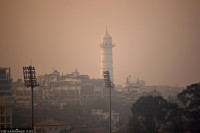Climate & Environment
Soaring temperatures at Kanyam Tea Estate break 50-year record, Dumkauli hottest in 44 years
Temperatures are rising at a faster pace in the hills and mountains than in the Tarai region, Met official says. Maximum temperature in Kathmandu on Saturday was 33.3 degrees Celsius, highest so far this year.
Arjun Poudel
Amid the continued heat wave in many districts of the Tarai region that has severely affected daily life, several places around the country on Saturday observed record-breaking temperatures.
According to the Meteorological Forecasting Division of the Department of Hydrology and Meteorology, Kanyam Tea Estate of Koshi Province registered 29.5 degrees Celsius on June 2—the highest temperature recorded in the last 50 years.
On June 3 and 5, the place recorded 30 degrees Celsius. Earlier, on July 10, 1973, the place had recorded 29 degrees Celsius. Along with Kanyam Tea Estate, three other stations—Dumkauli, Okhaldhunga, and Dharan Bazar—also surpassed their previous record highs.
The met office said that Dumkauli of Nawalparasi district registered 43.8 degrees Celsius—the highest temperature recorded in the last 44 years.
The record-breaking temperatures were observed on June 4, 6 and 7. Earlier on June 5, 1979, the maximum temperature reported in the place was recorded at 43.7 degrees Celsius.
On June 5, Okhaldhunga recorded 31.3 degrees Celsius on June 6 and 31 degrees on June 7. On April 28, 1999, the place had observed a temperature as high as 30.9 degrees Celsius.
Dharan Bazar observed 39.3 degrees Celsius on June 7—the highest temperature recorded in the last 10 years. Earlier, on April 12, 2013, the maximum temperature was recorded at 38.8 degrees Celsius.
The met office said that 13 weather stations—Gaur of Rautahat, Jaleshwar of Mahottari, Lahan of Sarlahi, Diktel of Khotang, Rajbiraj of Saptari, Pakhribas of Dhankuta, Chatara of Sunsari, Biratnagar Airport, Tarahara of Sunsari and Phidim of Panchthar broke June’s highest records.
According to the latest weather update of the division, Bhairahawa recorded 41.2 degrees Celsius, Nepalgunj 40.8 degrees Celsius, Dhangadhi 40.6 and Simara 40.5 degrees Celsius. Birendranagar recorded 39.4 degrees Celsius and Janakpur recorded 38.4 degrees Celsius, according to the division. The maximum temperature in Kathmandu on the day was 33.3 degrees Celsius, the highest temperature of this year.
Last year, the maximum temperature of Kathmandu reached 32.6 on August 18.
On June 13 2012, maximum temperature of Kathmandu was recorded 35.2, the highest ever, met officials said.
As temperatures in many places of the central and western Tarai exceeded 40 degrees Celsius, many places of the region witnessed a heat wave on Saturday as well.
Heat waves will continue in the coming days in these areas, as no weather system has built up yet to cause rainfall.
“Heat wave will continue in the coming days as well in the Central and Western Tarai as no system has developed that will form clouds or cause rainfall,” said Rojan Lamichhane, a meteorologist at the division. “People may not get relief from the scorching heat until the start of the monsoon.”
A heat wave occurs when the maximum and minimum temperatures are usually hot over three days at a location.
This year, the Department of Hydrology and Meteorology issued a heat wave warning three times—once in April's third week and twice in June.
The met office said that the monsoon is likely to be delayed by a few days this year.
The monsoon season in Nepal generally begins on June 13 and ends on September 23. Last year, however, it entered the country eight days ahead of schedule.
Normally, after the arrival of the monsoon, it takes one week for the clouds to spread across the country.
With the maximum temperature reaching 40 degrees Celsius, many local units in the Tarai region have started shutting down schools. Health facilities in the Tarai region have started reporting an uptick in patient flows over the last several days.
Exposure to excessive heat usually results in headache, nausea, weakness, dizziness and fainting. Heat-related illnesses include heat stroke, heat exhaustion, heat cramps and heat syncope (fainting). Heat stroke is the most severe form of heat-related illness and requires immediate medical attention.
Doctors advised people not to come out of their homes in the afternoon and to take sufficient fluids and water to remain hydrated to avoid the adverse effects of scorching heat.
Globally, extreme temperature events are observed to be increasing in frequency, duration and magnitude, according to the UN’s health body.
Climate scientists blame climate change for the early onset of summer and intense heat.
The average annual maximum temperature of Nepal has risen by 0.056 degrees Celsius, according to a study conducted by the Department of Hydrology and Meteorology (DOHM) in 2017.
The study shows most districts have witnessed increasing temperatures annually.
“Compared to districts of the Tarai region, hilly and mountainous districts have been witnessing a rise in the maximum temperature of the day at a faster rate,” said Dr Archana Shrestha, spokesperson for the Department of Hydrology and Meteorology.
Meteorologists have forecast below-average rainfall in the upcoming season. The department’s climate section, which forecast weather conditions for four months (June 1 to September 30), said that most parts of the country are likely to experience an above-average maximum temperature due to the El Nino conditions, a climatic pattern that generally brings dry weather.
Nepal is one of the world’s most vulnerable countries to the climate crisis and has witnessed extreme weather events over the past decade and a half.




 5.4°C Kathmandu
5.4°C Kathmandu








%20(1).jpg&w=300&height=200)

